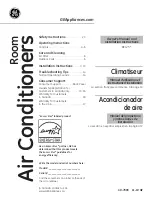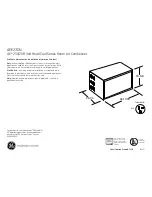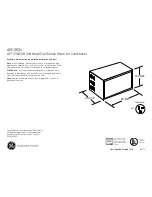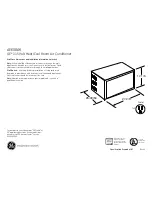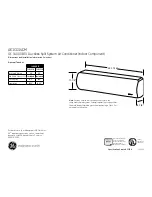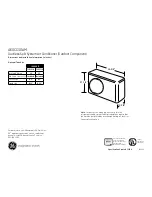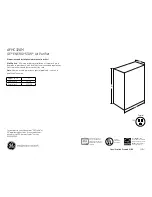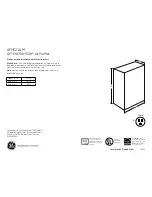
7
English
7-3 Daily service and maintenance
1.
Management of water quality
The plate type heat exchanger has a structure that does not permit
dismantling and cleaning, or replacing any parts. Please pay attention
carefully to the quality of water to be used for the plate type heat
exchanger in order to prevent corrosion and sticking of scale.
The water to be used for the plate type heat exchanger should have at
least the quality as specified in the table below.
When using any corrosion prevention agent, scale depressant agent,
etc, such agent should have no corrosive features against stainless
steel and copper.
2.
Management of chilled water flow rate
If the chilled water flow rate is not enough, it will result in the freezing
damage to the plate type heat exchanger. Check for any clogging of
the strainer, any air being caught, any reduction in the flow rate due
to failure of circulation pump by measuring the temperature and
pressure differences at the inlet and outlet ports of the plate type
heat exchanger. If the aged difference in the temperature or pressure
has increased beyond the proper range, the flow rate should have
decreased. Stop the operation and remove the cause before restart-
ing the operation.
3.
Steps to be taken when a freezing protection device was activated
When the freezing protection device should be activated during
operation, remove the cause without fail before restarting the opera-
tion. If the freezing protection device has been once activated, a par-
tial freezing has occurred. If you restart the operation without
removing the cause, the plate type heat exchanger will be closed
and the ice cannot be melted, and in addition, the freezing process
will be repeated resulting in any damage to the plate type heat
exchanger, leading to any such accidents that the refrigerant starts
leaking or water starts entering the refrigerant circuit.
7-4 Water quality
Water quality standards for chilled water, hot water and make-up
water (4) (6)
[NOTES]
(1) The circle marks in the columns for corrosion or scale to develop.
(2) Corrosion has a tendency to occur when water temperature is high
(104 °F or more), and if metals with no protective coating whatever
are directly exposed to water, it would be a good idea to take effec-
tive measures against corrosion such as adding a corrosion inhibitor
or deaeration treatment.
(3) In a condenser water circuit that uses a closed cooling tower, the
closed circuit circulating water and make-up water must satisfy its
water quality standards for the hot water system, and passing water
and make-up water must satisfy those for the circulation type cooling
water system.
(4) The supply water must be clean tap water, industrial water or clean
underground water.
Do not use purified or softened water.
(5) The fifteen items in the table above represent typical causes of cor-
rosion and scale.
(6) Once through water may cause corrosion.
Do not use once through water.
7-5 Maintenance of plate type heat exchanger
The performance of a plate type heat exchanger may decline due to
scale accumulation. It may be damaged by freezing due to the drop of
flow rate. For this reason, it is necessary to carry out programmed main-
tenances at a regular interval in order to prevent the scale from being
generated.
1.
Before entering the season for use, carry out the following
inspections:
1) Conduct a water quality test and make sure that it is within the
standard.
2) Clean the strainer.
3) Make sure that the flow rate is correct.
4) Make sure that the operational conditions (pressure, flow rate,
outlet temperature, etc.) are normal.
2.
Because the plate type heat exchanger has a structure which does
not permit disassembling and cleaning, follow the following proce-
dures for cleaning:
1) For maintenance purposes it is required to provide for a connec-
tion port on the water inlet and on the water outlet. You must con-
nect a circulation pump inbetween these 2 connection ports when
cleaning the plate heat exchanger with chemicals.
For cleaning the scale in the plate heat exchanger it is recom-
mended to use a solution with 5% diluted formic, citric, oxalic, ace-
tic or phosphoric acid.
Never use hydrochloric, sulfuric or nitric acid because such solu-
tions have a strong corrosive feature.
2) Make sure to provide for a stopvalve in front of that inlet water
pipe connection port and for a stopvalve after the outlet water
pipe connection port.
3) Connect the piping for circulation of cleaning chemicals to the
inlet and outlet piping of plate type heat exchanger. Fill the clean-
ing solution of 122 - 144 °F for a while in the plate type heat
exchanger. Then, circulate the cleaning solution by a pump for 2-
5 hours.
The time for cleaning depends on the temperature of cleaning
solution or the degree of scale accumulation. Therefore, please
watch the change of the dirtiness (color) of cleaning solution to
determine the level of removal of scale.
4) After circulating the cleaning solution, discharge the solution from
the plate type heat exchanger, fill the heat exchanger with a solu-
tion of 1-2% sodium hydroxide (NaOH) or sodium bicarbonate
(NaHCO
3
). Circulate this solution for 15-20 minutes for neutral-
ization purpose.
5) After the process of neutralization has been completed, rinse the
inner part of the plate type heat exchanger with care using fresh
and clean water.
6) When using any cleaning agent sold in the market, check in
advance that such agent has no corrosive features against stain-
less steel and copper.
7) For details of cleaning method, ask the manufacturer of related
cleaning agent.
3.
After cleaning has been completed, make sure that the unit can be
operated in a normal fashion.
Item (5)
Cooling water system (3)
Hot water system (2)
Tendency (1)
Circulation system
Circulation
water
Make-up
water
Circulation
water
(68°F ~ 140°F)
Make-up
water
Corrosion
Scale
Standard items
pH (77°F)
6.5 to 8.2 6.0 to 8.0 7.0 to 8.0 7.0 to 8.0
{
{
Electrical Conductivity
(mS/ft)(77°F)
Less than
24.4
Less than
9.1
Less than
9.1
Less than
9.1
{
{
Chloride ions
(mgcl
–
/L)
Less than
200
Less than
50
Less than
50
Less than
50
{
Sulfate ions
(mgSO
4
2-
/L)
Less than
200
Less than
50
Less than
50
Less than
50
{
Acid consumption
(pH4.8) (mgCaCO
3
/L)
Less than
100
Less than
50
Less than
50
Less than
50
{
Total hardness
(mgCaCO
3
/L)
Less than
200
Less than
70
Less than
70
Less than
70
{
Calcium hardness
(mgCaCO
3
/L)
Less than
150
Less than
50
Less than
50
Less than
50
{
Ionic-state silica
(mgSiO
2
/L)
Less than
50
Less than
30
Less than
30
Less than
30
{
Reference items
Iron (mgFe/L)
Less than
1.0
Less than
0.3
Less than
1.0
Less than
0.3
{
{
Copper (mgCu/L)
Less than
0.3
Less than
0.1
Less than
1.0
Less than
0.1
{
Sulfate ion
(mgS
2-
/L)
Shall not be
detected
Shall not be
detected
Shall not be
detected
Shall not be
detected
{
Ammonium ion
(mgNH
4
+
/L)
Less than
1.0
Less than
0.1
Less than
0.3
Less than
0.1
{
Residual chlorine
(mgCl/L)
Less than
0.3
Less than
0.3
Less than
0.25
Less than
0.3
{
Free carbon dioxide
(mgCO
2
/L)
Less than
4.0
Less than
4.0
Less than
0.4
Less than
4.0
{
Stability index
6.0 to 7.0
—
—
—
{
{




























